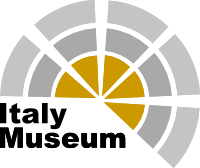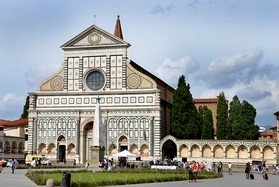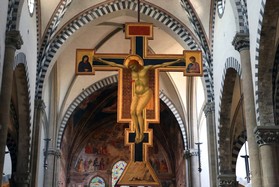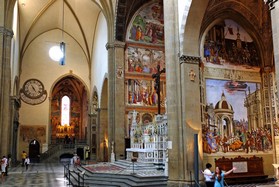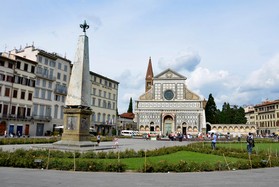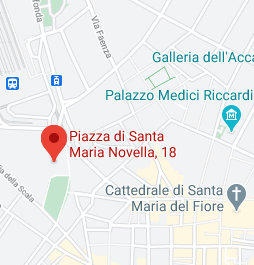Santa Maria Novella
A bit of history of Santa Maria Novella
Just as Santa Croce is linked to the Franciscan order, Santa Maria Novella is linked to the Dominican one. The monks of this order obtained the church of Santa Maria delle Vigne in 1221, called in this manner because at that time the area outside the church was surrounded by fields.
The renovation of the church was completed towards the middle of the 14th century, with the convent also annexed. Still, the consecration arrived only in 1420. It was precisely in this century that the Rucellai family took an interest in the building and commissioned the famous architect Leon Battista Alberti to complete the façade. Leon Battista Alberti inserted the new Renaissance style into the old Gothic structure, while still managing to maintain an absolute harmony between the two styles.
Almost a century later, in the second half of the 16th century, Giorgio Vasari gave his mark to the church, adapting it to the tastes of the time. The church has been restored several times over the centuries and the facade, although it is one of the most important works of Florentine Renaissance architecture, was only finished in 1920, when the right sail was added, the only part that remained incomplete until then.
What is Santa Maria Novella today?
The Basilica is one of the most important religious buildings in Florence. It is the first to welcome visitors who arrive in the city from the train station which is called Santa Maria Novella, in honour of the beautiful church. Besides being a worship place, the church is above all an exhibition space of undoubted prestige, thanks to the presence of works by many of the greatest artists of the Renaissance era, who wanted to leave their mark in the church. The complex is also formed by the beautiful outdoor spaces, which include the Green Cloister, with the frescoes "on the green ground" (thus the name) by Paolo Uccello; the Cappellone degli Spagnoli and the Cloister of the Dead. Also, the refectory, which is a real exhibition space, houses paintings and sacred vestments, goldsmith, relics and liturgical garments. Finally, linked to the Basilica is the Santa Maria Novella Pharmacy, the oldest in Europe, which has been open continuously for more than four centuries.
Curiosity about Santa Maria Novella
The façade has some exciting details. If you look closely at the marble frieze of the entablature, you will notice that it is decorated with ships with puffed sails and loose shrouds. That is the symbol of the Rucellai, the family of merchants who financed the construction of the " face" of the basilica. Their name is also immortalized on the upper architrave through an inscription in Latin: IOHA(N) NES ORICELLARIUS PAV(LI) F(ILIUS) AN(NO) SAL(VTIS) MCCCCLXX ("Giovanni Rucellai, son of Paul, year 1470").
Did you know that the façade of the church was also used to make astronomical measurements? On one side of the left door and one side of the right door are an armillary and a sundial respectively. The armillary consists of two graduated metal circles which were used to determine the days of the solstice and equinox. The sundial consists of three gnomons (rods) which were used to calculate the time in the various phases of the day (sunrise, noon and sunset). In the city of Florence, there are many other famous places where you can find sundials, such as the lantern of the Duomo, Ponte Vecchio, Forte Belvedere and the Galilei Museum, among others.
How can I visit Santa Maria Novella?
To visit the church, you can buy the skip-the-line entrance ticket to Santa Maria Novella + the audio guide of the city of Florence, the audio guide of the city that offers the best museums and fascinating art galleries.
Other attractions in the area
Florence is famous all over the world for being an open-air museum and also for its "indoor museums". You cannot miss the wonders of the Uffizi Gallery or the hundreds of works on display in the Palatine Gallery or the Accademia Gallery.
Other churches await you, such as the Cathedral of Santa Maria del Fiore (the Duomo) with Brunelleschi's magnificent Dome and Giotto's Bell Tower, and the Opera del Duomo Museum connected to it.
Finally, discover also the surroundings of Florence with short trips "out of town". For example, you can visit the beautiful Pisa with its characteristic Piazza dei Miracoli (Square of Miracles), which houses the famous Leaning Tower. And if one tower is not enough and you want many, then you must go to San Gimignano, which vertical houses are visible in the distance and testify the medieval past of the city.
You may be interested in:
Borghese Gallery in Rome, Doge's Palace Secret Itineraries Tour in Venice or some Tours in Milan.
Useful Information
Open Friday, Saturday and Monday from 10:00 am to 5:00pm and Sundays from 1:00 pm to 5:00 pm.
Closed on Tuesdays, Wednesdays and Thursdays, January 1st, Eastern, May 1st, August 15th and December 25th

+39 055713655
Reach the museums in total comfort with our transfer service!
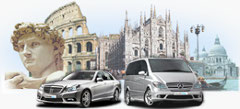
TRANSFER SERVICE
Book Now
